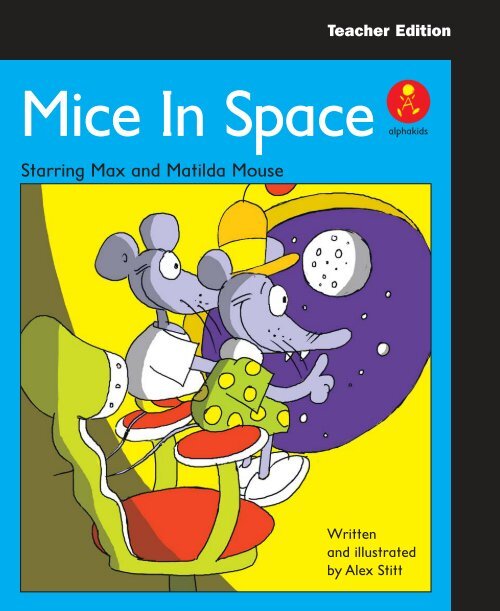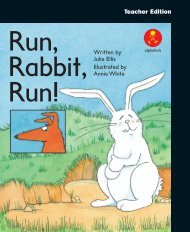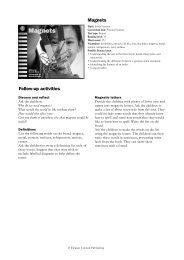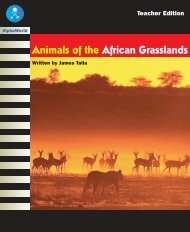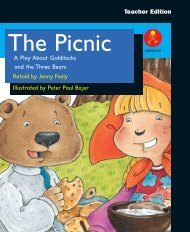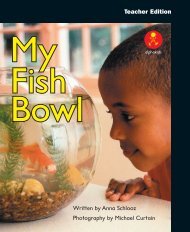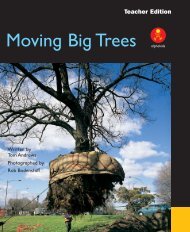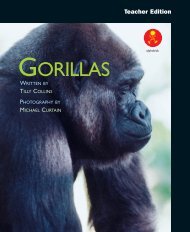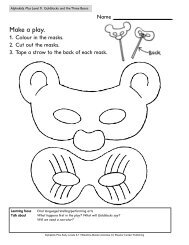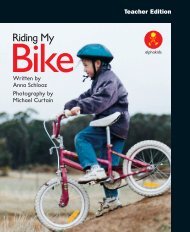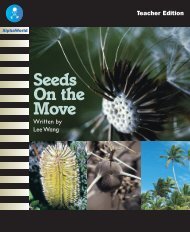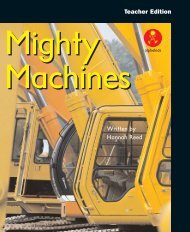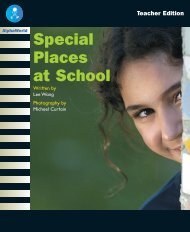L12 TEpp Mice In Space
L12 TEpp Mice In Space
L12 TEpp Mice In Space
You also want an ePaper? Increase the reach of your titles
YUMPU automatically turns print PDFs into web optimized ePapers that Google loves.
Teacher Edition<strong>Mice</strong> <strong>In</strong> <strong>Space</strong>alphakidsStarring Max and Matilda MouseWrittenand illustratedby Alex Stitt
Horwitz EducationA Division of HorwitzPublications Pty Ltd55 Chandos StreetSt Leonards NSW 2065AustraliaHorwitz GardnerEducationUnit 53, CressexEnterprise ParkLincoln RoadHigh Wycombe,Bucks, HP12 3RL,United KingdomPublished edition© Eleanor CurtainPublishing 2003First published 2003Apart from any fair dealing forthe purposes of study, research,criticism or review, aspermitted under the CopyrightAct of Australia, no part of thisbook may be reproduced byany process, or transmitted inany form, without permissionof the copyright owner. Wherecopies of part or the whole ofthis book are made under PartVB of the Copyright Act, thelaw requires that records ofsuch copying be kept and thecopyright owner is entitled toclaim payment.Developed byEleanor Curtain PublishingText: Elizabeth GoldingConsultant: Susan HillDesigned byAlexander StittProduction byPublishing SolutionsPrinted in Hong KongISBN 0 7253 2822 3Pack ISBN 0 7253 2750 2(6 Student Books + 1 TeacherEdition)1 2 3 4 5 6 7 8 903 04 05?How to use this bookBefore reading: TalkthroughTalk through the book with the children. Encouragethem to predict the text from the cover and pictures,and to think about the information they provide.Direct the children’s attention to aspects of the textthat may challenge them. Support the children to dealwith these challenges by asking the Talkthroughquestions on each page.During reading: Observe and supportObserve the children as they read. Encourage them tomonitor their own reading as they comprehend thetext. As needed, support children by assisting them todiscover and use reading strategies and cues to solveproblems and respond to reading challenges that arisein the text. <strong>In</strong>terruptions to the child’s reading shouldbe minimal and focused on a specified learning need.After reading: Comprehension, returning tothe text, responding and writing linksTo further develop children’s understanding of thetext, select from activities found on page 12 and theinside back cover. These whole text, sentence and wordlevel activities reinforce the teaching focus of thisbook. Assessment ideas are provided to assist withplanning for further teaching.Text highlights• Displays all the features of a comic book• Speech balloons indicate direct speech• Captions are used to narrate the text• Words within the illustrations indicate soundeffects: Whoosh! Roar!• Illustrations extend the storyVocabularystarring, puff, government, centre, danger,mice-ies, whoosh, alert, engines, roar, function,activated, crew
Setting the contextEnsure that the children arefamiliar with theconventions of comics:speech balloons, order ofreading each cell, use ofbold or larger text foremphasis, use of captions.Ask: Can a comic book tell usa story?<strong>In</strong>troducing the bookThis book is a comic bookabout two mice that are beingchased by a cat. Theyescape from the cat byhiding in a rocket and travelinto space.<strong>Mice</strong> <strong>In</strong> <strong>Space</strong>Starring Max and Matilda Mousealphakids<strong>Mice</strong> <strong>In</strong> <strong>Space</strong>Starring Max and Matilda MouseWritten and illustrated by Alex StittWrittenand illustratedby Alex StittalphakidsFront coverDirect children’s attention to the title andthe sub-heading.Do you see a sub-heading on every book youread?Ask children to note the author because inthis case he is also the illustrator.What do you notice about the illustration onthe cover?Title pageRead the title page together.Why do you think that Alex Stitt has drawnthe mice popping out of the stars? Howwould you describe each of the mice?
<strong>Mice</strong> <strong>In</strong> <strong>Space</strong> Pages 2–3?TalkthroughA big cat is chasing Max and Matilda. Do you think that thebig cat often chases them? What does the sign say on thefence? Do you think that this is a good place for Max andMatilda to hide?Observe and supportCan the child identify words with double letters in them?Can you find me a word that has double letters in it? Whatother words have double letters in them as well? (little,puff, street, hurry, will)2
One night a bigcat was chasingtwo little micedown the street.Grrrr!Look!Here is a bigfence.Puff! Puff!Hurry upMatilda!We arelittle. Wecan getunder it.Thefence willkeepthat bigcat out.233
<strong>Mice</strong> <strong>In</strong> <strong>Space</strong> Pages 4–7?TalkthroughRead the text on pages 4–5.Where do we start reading? Where do we read next? Whatdo you think about the hiding place that the mice havefound?Turn the page.Do you think that the big cat will catch the mice? Why orwhy not? What do you think will happen when Max pushesthe button?Observe and supportCan the child follow the story within the comic bookformat? Ask the children to direct you around pages 6–7.Where do I read next? How do you know?4
What’sthis?There’sa doorway upthere.I don’tknow.We’ll climb up.We can hide inside.So the mice climbed upand went inside.Look!It’s a spacerocket!45The big cat was following them.Those mice aren’tgoing to get awayfrom me.<strong>In</strong>side the space rocket . . .What doesthis buttondo?Here I come, mice-ies!Pleasedon’t push thatbutton, Max.Too late!675
<strong>Mice</strong> <strong>In</strong> <strong>Space</strong> Pages 8–11?TalkthroughLook at pages 8–9.Why does the big cat say ‘Oh no!’? Why do the mice say ‘Ohno!’? Is it for the same reason?Direct children’s attention to the word ‘Whoosh!’.Why is this word outlined in large letters?Turn to page 11.What do the men feel about the rocket taking off? Why doyou think this?Observe and supportCan the child interpret information in the text?What has happened? Where are they heading? What do youthink that they will do now?Look at the text on page 10.Why are there question marks in Max’s speech bubble?6
There was a loud bang.The space rocket took off.Oh no!Oh no!89Oh, Max—where arewe?We’re inspace!Back at the space rocket base,bells were ringing.Our rocket hastaken off!How?How will weget back?????10117
<strong>Mice</strong> <strong>In</strong> <strong>Space</strong> Pages 12–15?TalkthroughWhy do Max and Matilda seem to be happier? What do youthink will happen next?Turn to pages 14–15.How did the rocket come back to Earth? Do you think thatMax and Matilda enjoyed their trip?Observe and supportDoes the child stop and correct an error?I like the way that you stopped to check that you werereading the text in the correct order. I also like the way youre-read the sentence to make sure that it made sense.8
With all thoseholes, it looks likecheese to me.Cheese?Wow!Look at theMoon, Matilda!I wonder whatit’s made of?Yum! Maybe I’ll goout and get some.Oh,noyouwon’t!1213Just then—What happened?We’relanding!Quick—let’s getout ofhere.The rocket hasturned around.We have turnedthe rocket around.It is coming back.The space rocket crew went to the space rocket.There’s nobody in here.How did it take off?14159
<strong>Mice</strong> <strong>In</strong> <strong>Space</strong> Page 16?TalkthroughThe big cat is peeking around the corner! Do you think thatthe big cat will catch them? Where could Max and MatildaMouse hide this time? Will the big cat ever catch them orwill they always play this chasing game?Observe and supportDoes the child read the text with expression?Look at the box at the top of the page. What do you thinkMax and Matilda would be feeling? Look at the next box.How would they be feeling now?When children read the text, remind them to think abouthow the characters are feeling.What might the big cat’s voice sound like? Why do you thinkhe says, ‘Hello, mice-ies.’?10
The miceran off downthe street.Thatwas fun!Hello, mice-ies.Oh no!1611
<strong>Mice</strong> <strong>In</strong> <strong>Space</strong>Being a meaning makerEncourage the children to supporttheir answers with evidence from thebook as they discuss these questions:Why did the mice run into the rocket?How did the mice end up in space?What kind of character is Max Mouse?Is the Moon really made of cheese?Being a code breakerExplore the following languagefeatures:• The rime ‘ace’: space, face, ace,trace, mace, lace, pace.• The rime ‘ice’: mice, nice, lice,twice, dice, rice, vice.Being a text userPoint out the different features of thecomic and ask the children to explainwhat they mean or how to read them.Focus on:• Use of speech balloons.• Order of reading each cell.• Use of bold or larger text foremphasis.• Use of captions.Being a text criticThe author has named the two miceMax and Matilda.Why do you think he did this?The author has the boy mouse causingall of the trouble. Is this fair?Are boys more likely to cause trouble?Why do you think that?12
Responding to textProvide children with a range ofappropriate comics. Ask themto compare and contrast theillustrations and stories.What types of comics do you prefer?What do you like about the illustrations?Re-read the text focusing on thepunctuation and the use of boldor larger text to emphasise meaning.Turn to page 6.How would you read the text on thispage? What would the voice of the bigcat sound like when he says ‘Here Icome, mice-ies!’?Children work in pairs to explore thecharacters’ voices and the varied linesof text that they say.Writing links<strong>In</strong>dependent writingDiscuss the plot with the childrenand encourage them to write the nextadventure of Max and MatildaMouse, continuing on from page 16.What could Max and Matilda get up tonext? How would the big cat be involvedin the adventure?These could be presented using acomputer drawing program andturned into a slide show.Alternatively, children could work onpaper to make a comic book.Ask children to list all thewords in the book that arefollowed by an exclamation mark.What do they add to the text?AssessmentCan the child:• Explain the features of comics?• Follow a story as contained within speech balloons?• Explain some differences between comics and other narratives?whole text activity sentence activity word activity
<strong>Mice</strong> <strong>In</strong> <strong>Space</strong>Starring Max and Matilda MousealphakidsTeacherEditionOther booksat this levelLooking LikePlantsalphakidsWrittenand illustratedby Alex StittWritten by Hannah ReedPhotography by Gary LewisTopic: HumourCurriculum link: EnglishText type: NarrativeReading level: 12Word count: 245Vocabulary: starring, puff, government, centre,danger, mice-ies, whoosh, alert, engines, roar,function, activated, crewPossible literacy focusUnderstanding the conventions of comics.Reading speech balloons.Exploring how stories in comics differ from othernarratives.SummaryThis comic book tells the story of how two miceescape from a cat by hiding in a rocket andtravelling to space. The conventions of a comicbook are used to tell the story.My Pet LambalphakidsWritten by Jack HastingsPhotography by Michael CurtainalphakidsWritten by Emma RossiPhotography by Michael CurtainLet’s MakePancakesTreasureHuntWrittenby Jack HastingsPhotography by Michael CurtainDon’t Worry!Written by Christopher Stitt Illustrated by Steve AxelsenalphakidsalphakidsISBN 0- 7253- 2822- 39 780725 328221alphakids


